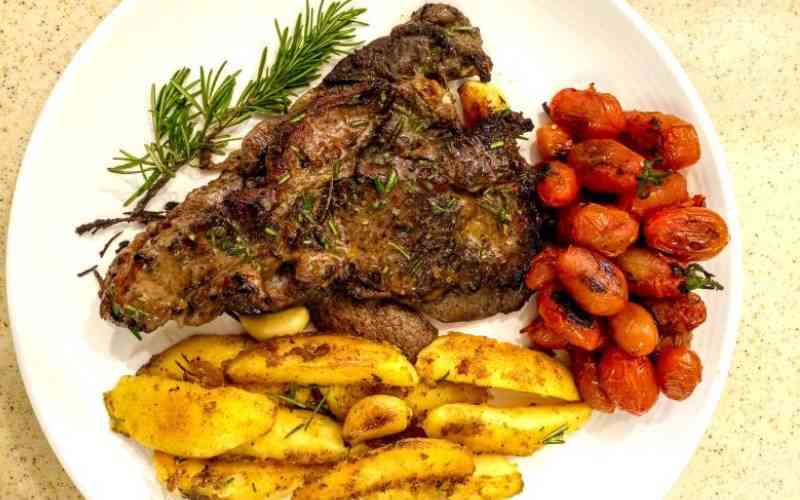
From afar, it looks like partitioned sorghum farms sandwiched by fruit trees. Up-close, the sorghum-like grass known as vetiver looks rich surrounding Tilomwonin village in Kamnarok that lies on the base of the Kerio Valley belt.
The unique grass, which is fast transforming the Kerio Valley belt, was once a dream hatched thousands of miles away in India during a visit by Aron Kangwony, a former Kenya Airways employee.
"During a visit to one of the villages not far away from Mumbai airport, I came across vetiver grass which I really liked," says Kangwony.
"I thought it could do really well especially back in my village that was facing a lot of challenges with soil erosion. Being a dry area, I also thought the grass would be good for fodder," he adds.
However, Kangwony's dream was not achieved until later in 2004 when the Kenya and India governments gave him a nod to import ten stems of vetiver grass after making several applications.
Some 18 years later, half of Kangwony's two-acre farm now hosts the grass, which he says is the largest vetiver farm within the Kerio Valley.
Vetiver, also known as the 'miracle grass' due to its many benefits, is native to India and thrives in tropical regions. The grass has a deep and dense root system that binds soil together to prevent erosion.
It is used as fodder for animals and as mulch for improving soil moisture and boosting soil fertility. The grass is also known for its resilience in withstanding adverse environmental and climatic conditions.
Since its introduction by Kangwony in 2004, the grass has since been adopted by farmers in the neighbouring Elgeyo Marakwet County and by conservation organisations mainstreaming climate-smart agriculture in the region.
"I did not know this grass would define my retirement plan. The grass grew to become a business venture and is now transforming this delicate ecosystem which is prone to soil erosion," he says.
Effects of soil erosion are adverse on Lake Kamnarok, an ox-bow lake that lies at Lake Kamnarok national reserve, some three kilometres away from Kangwony's farm. The reserve also borders Rimoi national reserve in Elgeyo-Marakwet.
In previous years, the lake ranked as the second-largest host to crocodiles in Africa after Lake Chad. It is also a critical dispersal area and an ancient corridor utilised by African elephants. It remains one of the largest remaining elephant ranges traversing Baringo, Elgeyo Marakwet, West Pokot and Turkana Counties.
But today, the lake has been choked to the brim by silt. A 2020 research published on the Journal of Geoscience and Environment Protection states the Kerio Valley ecosystem faces challenges of soil loss due to massive degradation.
The research, which aimed at assessing soil erosion and climate variability on the Kerio Valley basin, further reveals that the loss of top soil has led to excessive degradation of the valley, causing soil loss in the basin and subsequently depositing it in Lake Kamnarok, exposing it to the threat of extinction.
"Due to excessive runoff water, much of the top soil was carried away, thus ending up settling on Lake Kamnarok causing a lot of silt deposition, and hence reduction of water capacity," the study read.
But Kangwony is confident that vetiver grass might offer a solution to the erosion. In 2014 during a reclamation exercise, vetiver grass was planted alongside the gabions along an aggressive gulley that is draining water out of the lake.
Kangwony says not much follow-up was done afterwards, but he believes the grass can still be planted in large scale not only within the wetland, but also within the entire ecosystem to prevent further siltation.
He has since mastered the art of propagating grass seedlings and reclaiming highly degraded areas, and now sells cuttings to other farmers.
One original cutting sells at Sh15, and a propagated cutting sells at Sh50. Kangwony says he has supplied several cuttings to farmers in Bomet, Kericho and Kitui.
And while the grass species might be the solution of the challenge being experienced downstream at Lake Kamnarok, the status of the lake still remains critical as it is highly silted and the aggressive Kiptilit gulley that has been emptying the lake into Kerio river is growing wider with time.
"A lot has to be done to save this lake. Its state is not good at all and siltation has been the biggest threat. Siltation happens as a result of poor farming practices upstream and destruction within the national reserve," says James Kibet, an administrative assistant at Lake Kamnarok.
Kibet says while there is need for reforestation, vetiver grass remains a viable option.
Baringo County Director for Environment, Evans Kandie, said the Kamnarok ecosystem is among the delicate ecosystems in the county that needs restoration to curb the challenge of soil erosion.
 The Standard Group Plc is a multi-media organization with investments in media platforms spanning newspaper print
operations, television, radio broadcasting, digital and online services. The Standard Group is recognized as a
leading multi-media house in Kenya with a key influence in matters of national and international interest.
The Standard Group Plc is a multi-media organization with investments in media platforms spanning newspaper print
operations, television, radio broadcasting, digital and online services. The Standard Group is recognized as a
leading multi-media house in Kenya with a key influence in matters of national and international interest.

